The U.S.-born children of Hispanic and Asian-American immigrants are strikingly similar in how they identify with their native America. About six-in-ten of both groups say they consider themselves to be a “typical American.” That is roughly double the share of their immigrant forebears who say the same.24
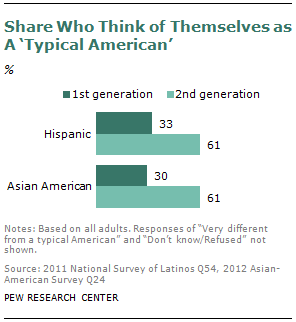 But for these adult children of immigrants, seeing oneself as a typical American has not meant losing their overriding sense of identity with their family roots. A majority of the second generations of both groups say they most often identify themselves either by their ancestral country of origin (e.g., Mexican; Chinese American) or by a pan-ethnic or pan-racial term (e.g., Hispanic, Asian American).
But for these adult children of immigrants, seeing oneself as a typical American has not meant losing their overriding sense of identity with their family roots. A majority of the second generations of both groups say they most often identify themselves either by their ancestral country of origin (e.g., Mexican; Chinese American) or by a pan-ethnic or pan-racial term (e.g., Hispanic, Asian American).
A minority of second-generation Hispanics (37%) and Asian Americans (27%) say they most often describe themselves simply as “an American.” Notably, however, these shares are substantially higher than the shares among the immigrant generations of these groups who say the same (8% for Hispanics, 9% for Asian Americans).
These findings come from an analysis of recent Pew Research Center surveys conducted with a nationally representative sample of Hispanics and a separate representative survey of Asian Americans.
Those surveys, along with our analysis of U.S. Census Bureau data, also find that Latinos and Asian Americans differ markedly both in their language skills and in their views on the importance of maintaining the language of their ancestral home. While fully three-fourths (78%) of Asian immigrants in the U.S. speak English either very well or pretty well, about half of Hispanic immigrants (48%) are English proficient. This may reflect the fact that a large share of Asian American immigrants are highly educated and often come to the United States to obtain even more education, while a large share of Hispanics who come to the U.S. have less education and come primarily to work.
Among the second generation, half of Latinos have the ability to speak Spanish, while less than half of Asian Americans are proficient in the language of their ancestral home. And as with Hispanics and Asian Americans overall, second-generation Hispanics are far more wedded to future generations retaining their ancestral language than are second-generation Asian Americans.
Self-Identification
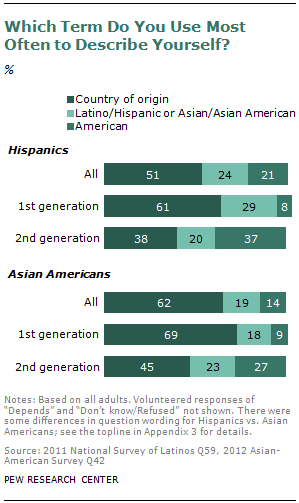 When asked how they most often describe themselves, about six-in-ten (61%) foreign-born Latinos use a term linked to their country of origin (e.g., “Mexican”). Only half that many (29%) report that they call themselves a pan-ethnic term such as “Hispanic” or “Latino.” And just 8% of Latino immigrants say that they most often call themselves “American.”
When asked how they most often describe themselves, about six-in-ten (61%) foreign-born Latinos use a term linked to their country of origin (e.g., “Mexican”). Only half that many (29%) report that they call themselves a pan-ethnic term such as “Hispanic” or “Latino.” And just 8% of Latino immigrants say that they most often call themselves “American.”
Patterns among the second generation show marked differences. A notable minority (38%) still identifies primarily with their family’s country of origin, and 20% most often call themselves either “Hispanic” or “Latino.” However, second-generation Latinos are far more likely than their foreign-born counterparts to most often call themselves “American”—37% do.
This pattern of self-identification across generations is quite similar to that of Asian Americans. Among the foreign born, some 69% report that they most often classify themselves by their country of origin (e.g., “Chinese American”). Asian immigrants are slightly less likely than their Hispanic counterparts to identify by a pan-ethnic or pan-racial term, but still almost two-in-ten (18%) identify as “Asian” or “Asian American.” Finally, some 9% of Asian immigrants state that they most often identify themselves as “American.”
As with Latinos, the share of second-generation Asian Americans who identify primarily by their country of origin is smaller than it is among the first generation. Some 45% of second-generation Asian Americans say as much. The share of second-generation Asian Americans who identify primarily as “Asian” or “Asian American” is 23%, not much different than the share in the first generation who say the same. Second-generation Asian Americans, though, are much more likely to describe themselves as “American,” with about one-fourth (27%) saying they do so.
Do You Think of Yourself as a Typical American?
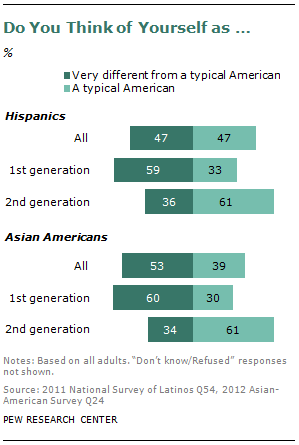 Though the bulk of Latinos continue to identify themselves based upon their country or region of origin, many also think of themselves as a typical American. Fully one-third (33%) of immigrants say as much, as do more than six-in-ten (61%) second-generation Latinos. Conversely, 59% of immigrant Latinos and about one-third (36%) of second-generation Latinos report that they think of themselves as very different from a typical American.
Though the bulk of Latinos continue to identify themselves based upon their country or region of origin, many also think of themselves as a typical American. Fully one-third (33%) of immigrants say as much, as do more than six-in-ten (61%) second-generation Latinos. Conversely, 59% of immigrant Latinos and about one-third (36%) of second-generation Latinos report that they think of themselves as very different from a typical American.
The patterns of response on this question among Asian Americans are almost identical. Some 30% of Asian immigrants think of themselves as a typical American, as do 61% of second-generation Asian Americans, while 60% of Asian immigrants and 34% of second-generation Asian Americans think of themselves as very different from a typical American.
English-Speaking Ability25
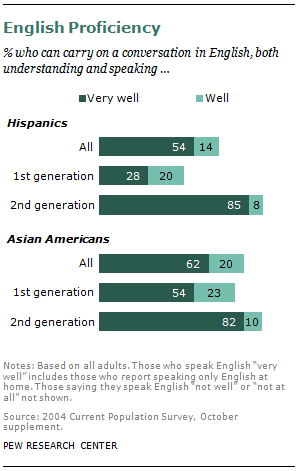 English-speaking ability is limited among Hispanic immigrants in the U.S. Less than half (48%) of foreign-born Latinos can converse in English either very well or well: About one-fourth (28%) report speaking English very well, and 20% report speaking the language well. One-fifth (20%) of Latino immigrants speak no English at all, and about one-third (32%) don’t speak the language well.
English-speaking ability is limited among Hispanic immigrants in the U.S. Less than half (48%) of foreign-born Latinos can converse in English either very well or well: About one-fourth (28%) report speaking English very well, and 20% report speaking the language well. One-fifth (20%) of Latino immigrants speak no English at all, and about one-third (32%) don’t speak the language well.
However, the vast majority (93%) of second-generation Latinos report that they can speak English either very well (85%) or well (8%).
Patterns of English proficiency are quite different among Asian American immigrants compared with their Hispanic counterparts. Fully three-fourths (78%) speak English either very well (54%) or well (23%). About 6% don’t speak English at all, and the remaining 17% don’t speak the language well.
As with second-generation Latinos, the vast majority of second-generation Asian Americans speak English either very well or well. About nine-in-ten of this group report that they speak English either very well (82%) or well (10%).
Retaining the Language of the Ancestral Home
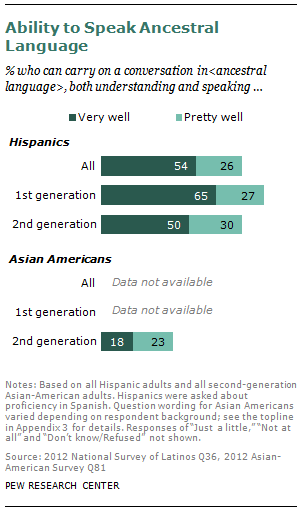 The ability to speak Spanish persists for a large share of second-generation Hispanics, with eight-in-ten reporting that they can converse either very or pretty well in that language: Fully half (50%) report that they can speak Spanish very well, and 30% report that they can speak it pretty well. An additional 16% of second-generation Latinos report that they can speak just a little Spanish, and 4% report no ability to speak Spanish.
The ability to speak Spanish persists for a large share of second-generation Hispanics, with eight-in-ten reporting that they can converse either very or pretty well in that language: Fully half (50%) report that they can speak Spanish very well, and 30% report that they can speak it pretty well. An additional 16% of second-generation Latinos report that they can speak just a little Spanish, and 4% report no ability to speak Spanish.
Among second-generation Asian Americans, the story is quite different. Just 4-in-10 (41%) report that they can speak the language used in their familial country of origin either very well (18%) or pretty well (23%). The plurality of second-generation Asian Americans (33%) report that they speak just a little of the language from their family’s country of origin, and fully one-fourth (26%) report that they don’t speak that language at all.
The Importance of Retaining the Language of the Ancestral Home
 Very different attitudes may explain, in part, the stark differences in the likelihood that Latinos and Asian Americans maintain the ancestral language beyond the first generation. Respondents were asked how important it is that future generations living in the U.S. be able to speak the language of the familial homeland. On average, Hispanics were far more likely than Asian Americans to believe this was important. And among both Hispanics and Asians, immigrants were more likely than their second-generation counterparts to say that maintaining the ancestral language is very important.
Very different attitudes may explain, in part, the stark differences in the likelihood that Latinos and Asian Americans maintain the ancestral language beyond the first generation. Respondents were asked how important it is that future generations living in the U.S. be able to speak the language of the familial homeland. On average, Hispanics were far more likely than Asian Americans to believe this was important. And among both Hispanics and Asians, immigrants were more likely than their second-generation counterparts to say that maintaining the ancestral language is very important.
Almost all (96%) foreign-born Hispanics feel that it is very or somewhat important for future generations to retain the ability to speak Spanish. Most (82%) consider it very important. Even among the second generation, some 94% of Latinos think it important for future generations to continue to speak Spanish, though they are a bit less adamant than the first generation. Some 68% of second-generation Latinos consider it very important for future generations to be able to speak Spanish. Third-generation Latinos are equally as likely as their second-generation counterparts to state that retaining the ability to use Spanish is very or somewhat important.26
In comparison, Asian Americans are less attached to the idea of maintaining the language of their familial homeland. While the majority (82%) of Asian immigrants say that it is very or somewhat important to do so, about half (49%) say that it is very important for future generations to retain the language of their homeland.
Second-generation Asian Americans are less likely than their immigrant counterparts to value the ability to speak the language of the familial homeland, with 37% reporting it is very important and 39% saying it is somewhat important.


